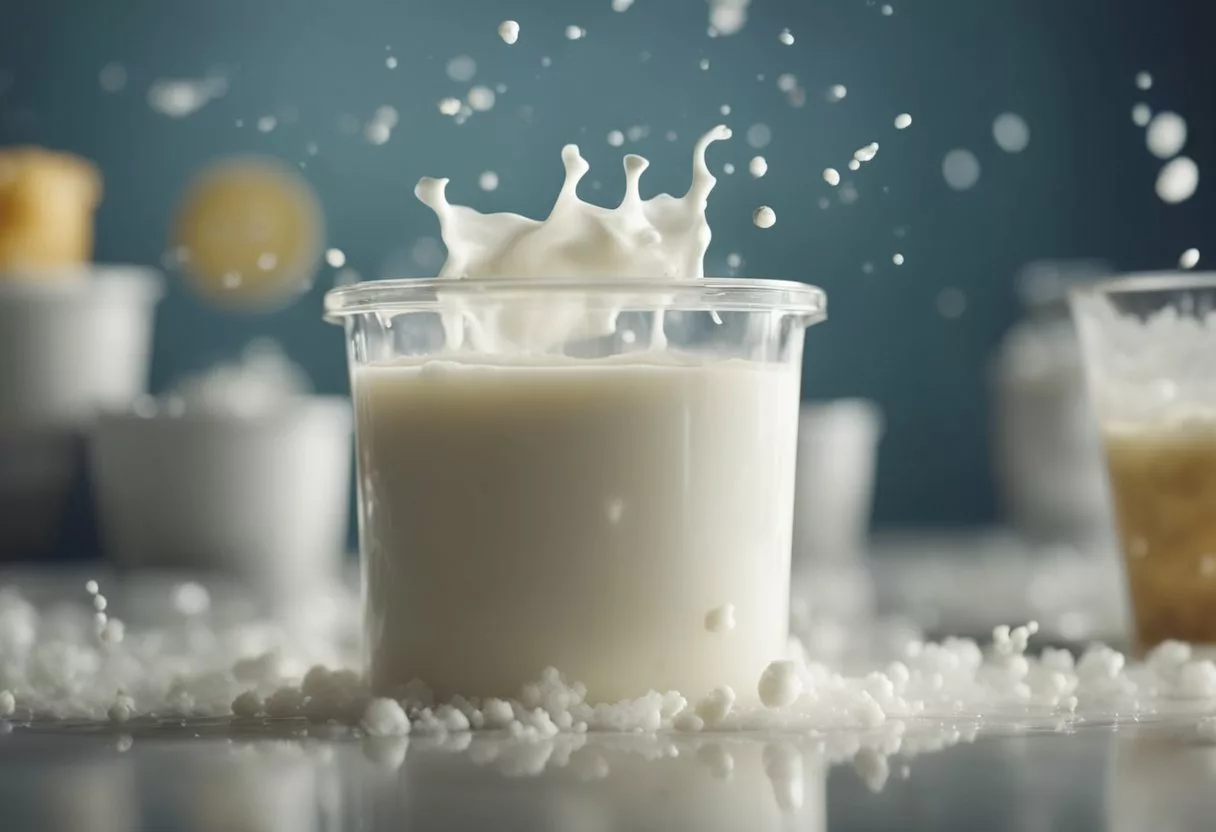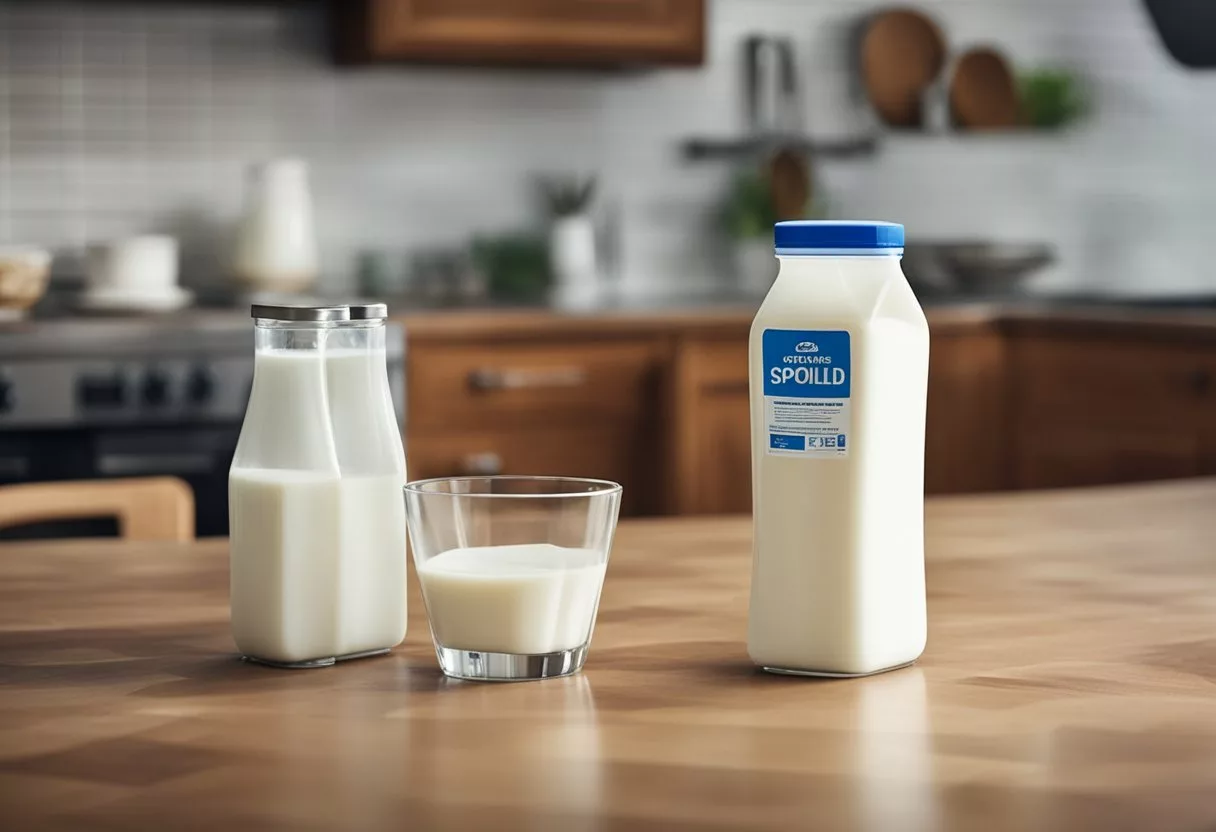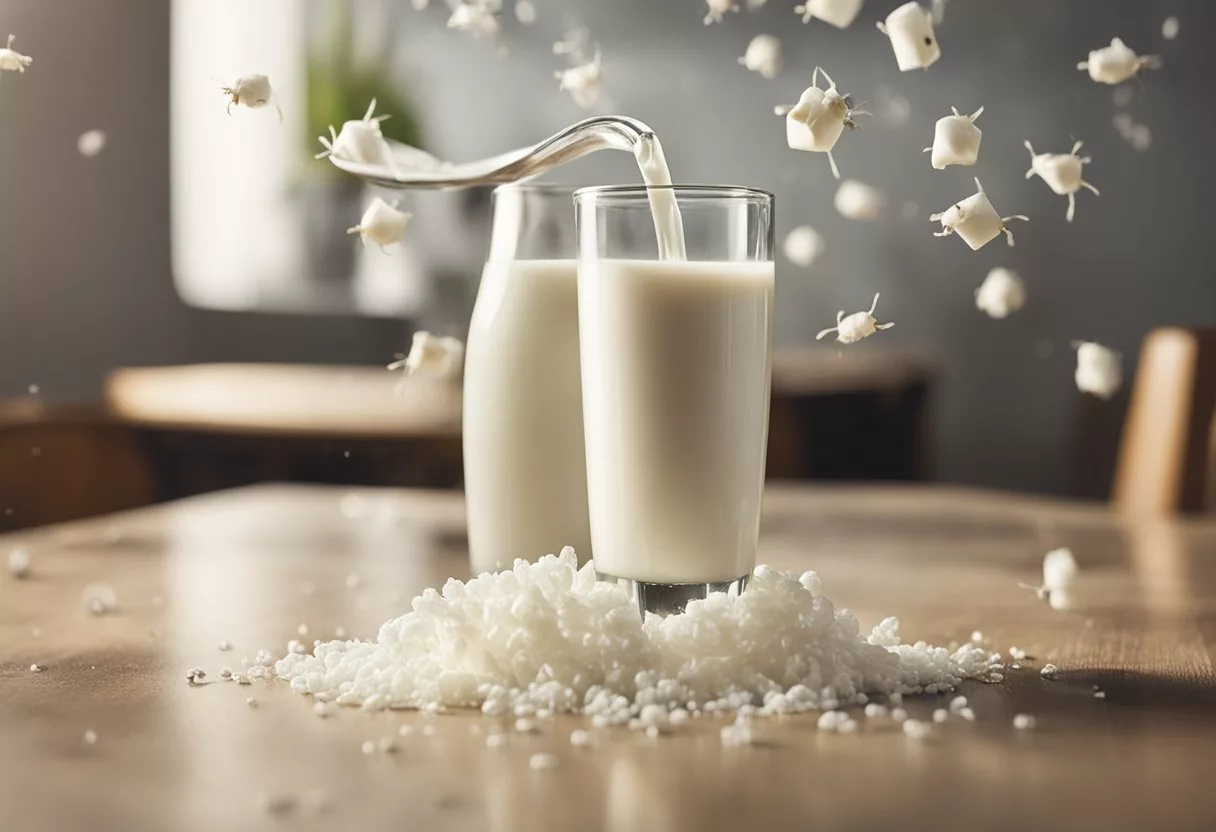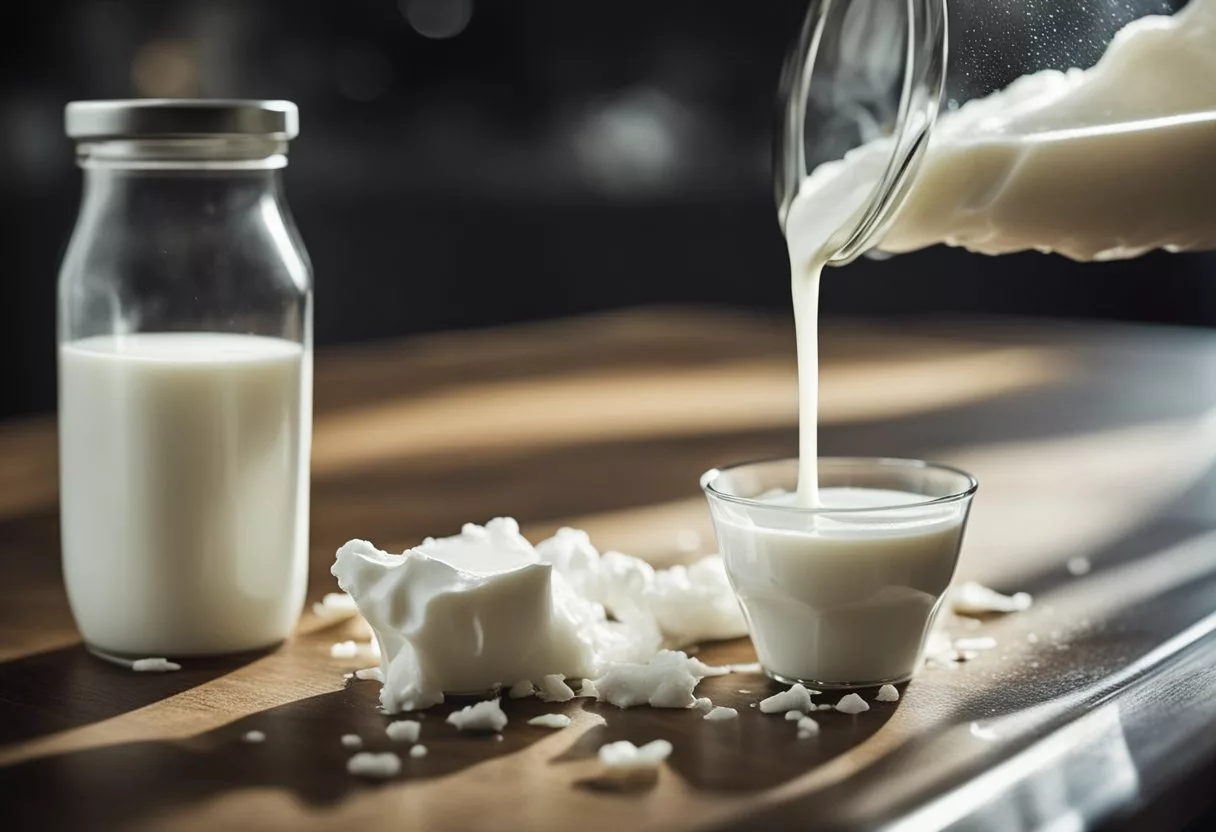Have you ever wondered what might happen if you accidentally drank spoiled milk? It’s a common concern, especially when we find a forgotten carton at the back of the fridge. Drinking spoiled milk can lead to food poisoning symptoms like stomach cramps, vomiting, and diarrhea.

Milk spoils due to bacterial growth, which changes its taste, smell, and texture. While a small sip of spoiled milk might not cause serious harm, consuming larger amounts can make you sick. It’s important to know how to spot spoiled milk and what to do if you’ve accidentally consumed it.
Luckily, there are ways to prevent milk from spoiling too quickly and even some surprising uses for milk that’s gone bad. Let’s explore what happens when milk spoils, how to stay safe, and what you can do with milk that’s past its prime.
Key Takeaways
- Spoiled milk can cause digestive issues and food poisoning symptoms.
- Proper storage and checking milk before consumption can prevent accidental ingestion.
- Milk that has gone bad can still be used in cooking and baking recipes.
Understanding Spoiled Milk
Milk can spoil quickly if not stored properly. Knowing how to spot spoiled milk is key to avoiding potential health issues.
What Constitutes Spoiled Milk?
Spoiled milk occurs when bacteria multiply in the liquid, causing changes in taste, smell, and texture. This process happens naturally over time, even in refrigerated milk. The Food and Drug Administration (FDA) regulates milk safety standards.
Pasteurized milk typically lasts 5-7 days past its sell-by date if refrigerated properly. Raw milk spoils faster due to lack of pasteurization.
Factors affecting spoilage:
- Temperature
- Exposure to light
- Container integrity
- Initial bacteria count
The Spoilage Process
As milk ages, bacteria break down lactose, proteins, and fats. This creates lactic acid, which gives spoiled milk its sour smell and taste.
Stages of milk spoilage:
- Fresh milk
- Slightly acidic
- Curdled and sour
- Moldy
The rate of spoilage depends on storage conditions and initial milk quality. Properly refrigerated milk slows bacterial growth, extending shelf life.
Identifying Spoiled Milk
Spotting spoiled milk involves using multiple senses:
Smell: A sour, unpleasant odor is often the first sign.
Appearance: Look for changes in color (yellowing) or texture (clumps or thickness).
Taste: If unsure, a small sip can confirm spoilage. Sour or off-flavors indicate spoiled milk.
Expiration date: While not foolproof, it’s a helpful guideline. Milk can spoil before or after this date.
Carton condition: Bulging or leaking containers may indicate spoilage.
When in doubt, it’s best to discard milk to avoid potential illness.
The Risks of Drinking Spoiled Milk

Consuming spoiled milk can lead to several health issues. The risks range from mild discomfort to more severe symptoms, depending on the amount ingested and individual factors.
Common Symptoms
Drinking spoiled milk often causes digestive discomfort. People may experience stomach pain and nausea within a few hours. Abdominal cramping is another frequent symptom. These issues usually don’t last long.
Vomiting and diarrhea can also occur. These symptoms help the body get rid of harmful substances. While unpleasant, they’re often short-lived.
Dehydration is a concern, especially with prolonged vomiting or diarrhea. It’s important to drink plenty of fluids if these symptoms arise.
Potential Food Poisoning
In some cases, drinking spoiled milk can lead to food poisoning. This happens when harmful bacteria like Salmonella, E. coli, or Listeria are present.
Food poisoning symptoms include:
- Severe abdominal pain
- High fever
- Chills
- Headache
These symptoms often start 1-3 days after drinking the spoiled milk. They can last for several days.
In rare cases, food poisoning can be serious. It may require medical attention, especially if symptoms are severe or long-lasting.
Impact on Vulnerable Populations
Certain groups face higher risks from drinking spoiled milk. These include:
- Young children
- Elderly people
- Pregnant women
- People with weakened immune systems
For these groups, even a small amount of spoiled milk can cause more severe symptoms. They may develop serious foodborne illnesses more easily.
Children are especially at risk. Their smaller bodies can’t handle toxins as well as adults. They also get dehydrated more quickly.
Pregnant women need to be extra careful. Some bacteria in spoiled milk can harm the fetus. It’s best for them to avoid any questionable dairy products.
Prevention and Safety Measures
Keeping milk fresh and safe to drink depends on proper storage and handling. Knowing when to discard milk is crucial for avoiding spoilage and potential illness.
Proper Storage and Handling
Store milk in the refrigerator at 40°F (4°C) or below. This temperature slows bacterial growth and keeps milk fresh longer.
Always return milk to the fridge promptly after use. Don’t leave it out on the counter or table.
Keep milk containers tightly sealed. This prevents absorption of odors from other foods and reduces exposure to bacteria.
Store milk on refrigerator shelves, not in the door. Door storage exposes milk to temperature fluctuations.
Use clean utensils when handling milk to avoid introducing bacteria.
For longer storage, freezing milk is an option. Frozen milk can last up to 3 months.
Understanding Expiration Dates
Milk cartons display various dates:
- Sell-by date: For store inventory management
- Use-by date: Manufacturer’s estimate of peak quality
- Best-by date: Another quality indicator
These dates are quality guidelines, not safety cut-offs. Properly stored milk often stays fresh past its printed date.
Pasteurized milk can typically last 5-7 days past the printed date if refrigerated properly.
Trust your senses. If milk smells or tastes off, it’s best to discard it regardless of the date.
When to Discard Milk
Discard milk if it shows signs of spoilage:
- Sour or unpleasant odor
- Chunky or lumpy texture
- Yellow or discolored appearance
- Sour or off taste
Even if milk looks and smells fine, discard it if it’s been left unrefrigerated for more than 2 hours.
The Missouri Poison Center advises that a small sip of spoiled milk is unlikely to cause harm beyond a bad taste. But drinking larger amounts can lead to food poisoning symptoms.
When in doubt, throw it out. This simple rule helps prevent foodborne illness and ensures food safety.
Health Implications and Treatment

Drinking spoiled milk can lead to digestive issues. Quick action and proper care can help reduce discomfort and prevent complications.
Self-Care After Ingestion
If you drink spoiled milk, you may feel sick to your stomach. You might throw up or have diarrhea. These problems often go away on their own within a day.
It’s important to stay hydrated. Drink plenty of water or clear fluids. Sports drinks can help replace lost electrolytes and sugar.
For babies and young kids, try an oral rehydration solution like Pedialyte. This can prevent dehydration, which can be dangerous for little ones.
Avoid solid foods until you feel better. When you start eating again, choose bland, easy-to-digest items.
Seeking Medical Attention
Most people get better without seeing a doctor. But sometimes, medical help is needed.
Call a doctor if:
- Symptoms last more than 24 hours
- You can’t keep fluids down
- You have a high fever
- You see blood in your vomit or poop
Severe cases may need treatment at a hospital. Doctors can give fluids through an IV to fix dehydration. They might also use anti-diarrheal medications.
If you’re not sure what to do, call a poison control center. They can give advice based on your symptoms.
Alternative Uses for Spoiled Milk

Spoiled milk doesn’t need to go to waste. It can be used in various ways in the kitchen and still provides some nutritional benefits.
In Cooking and Baking
Spoiled milk adds a tangy flavor to many recipes. It works well with baked goods like cakes, bread, and muffins. The sour taste enhances flavors and creates a moist texture.
In pancakes and waffles, spoiled milk can replace buttermilk. It also makes creamy salad dressings and marinades. Some cooks use it in mashed potatoes for extra richness.
Spoiled milk can be used to make homemade cheese. The process is simple:
- Heat the milk
- Add lemon juice
- Strain the curds
The resulting cheese works well in lasagna or as a spread.
Nutritional Considerations
While spoiled, milk still contains nutrients. It keeps most of its protein, fat, and sugar content. The fermentation process may even increase some nutrients.
Spoiled milk has live microorganisms. These can aid digestion for some people. But those with lactose intolerance should avoid it.
Key nutrients in spoiled milk:
- Protein
- Calcium
- Vitamin D
- Riboflavin
Heat kills harmful bacteria in spoiled milk. This makes it safer to use in cooked dishes. But drinking large amounts of spoiled milk can cause stomach upset.
Frequently Asked Questions

Drinking spoiled milk can cause health issues. The severity depends on various factors. Here are some common questions people have about consuming spoiled milk.
What should I do if I accidentally drank spoiled milk?
If you drank spoiled milk, rinse your mouth with water. Drink plenty of fluids to stay hydrated. Monitor your symptoms closely.
If you feel unwell, contact a healthcare provider for guidance.
Can consuming spoiled milk have life-threatening consequences?
Drinking spoiled milk rarely causes severe illness. Most people experience mild digestive discomfort.
In rare cases, food poisoning can occur. This may lead to dehydration, which can be dangerous if left untreated.
What are the risks of drinking spoiled milk during pregnancy?
Pregnant women should avoid spoiled milk. Their immune systems are weaker, making them more susceptible to foodborne illnesses.
Consuming spoiled milk while pregnant could potentially harm the fetus. It’s best to consult a doctor if this happens.
How much spoiled milk is required to cause illness?
The amount of spoiled milk needed to cause illness varies. It depends on factors like the person’s health and the milk’s bacterial content.
Even a small amount can cause digestive issues in some people. Others might drink more without any problems.
What are the common symptoms after ingesting spoiled milk?
Common symptoms include nausea, vomiting, and diarrhea. These usually start within a few hours of drinking spoiled milk.
Stomach cramps and fever may also occur. Most symptoms resolve on their own within 12-24 hours.
How can one tell if milk has gone bad prior to consumption?
Check the expiration date first. Smell the milk – a sour odor indicates spoilage.
Look for changes in texture or color. Spoiled milk may appear chunky or discolored. If in doubt, it’s best to discard the milk.